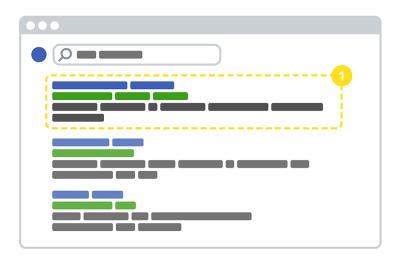Author
Marylee Williams
New Search Engine Tool Helps Users Make Sense of Unfamiliar Topics


An unstructured search for online information about new topics or products can be daunting.
Type "best strollers" into a search engine, and it will come up with dozens of articles, top 10 lists and sponsored brand posts. While consumers may initially find these results helpful, they could easily become overwhelmed because the information isn't useful. And they're left scratching their heads, trying to make sense of it all.
Researchers at Carnegie Mellon University's School of Computer Science (SCS) developed a prototype Google Chrome extension to help users avoid this scenario by improving sensemaking for unfamiliar topics. The extension, Selenite, creates a comprehensive overview of options and criteria to help people make personalized decisions. It is built on top of how people already do sensemaking online.
"When people search on Google for a topic they're unfamiliar with, they end up with a bunch of webpages where they need to sift through the data and make comparisons," said Michael Xieyang Liu, part of the Selenite team and a research scientist at Google DeepMind who earned his Ph.D. from the Human-Computer Interaction Institute (HCII) in SCS. "Selenite takes advantage of the vast trove of information available on the internet and the abilities of large language models (LLMs) to encode and process that information."
When a user visits a webpage, Selenite provides an overview of the options and criteria for this topic in a sidebar. With the stroller example, the options listed would include the brand of baby strollers, like UPPAbaby or Evenflo, and the criteria would include things that people commonly consider when purchasing a stroller, such as price, durability, maneuverability and more. Users can interact with the criteria, revealing descriptions to assist with sensemaking. Selenite employed GPT-4, an LLM created by OpenAI, as a knowledge retriever to source the list of common criteria about a topic.
Unlike other LLMs, Selenite augments how a user normally searches instead of replacing it with a chat interface, allowing users to make confident decisions about which sources to trust, what criteria are important to them and tradeoffs they are willing to make. The team's research suggests that an overview of important criteria or aspects of a topic could help people avoid feeling lost or unsure when researching something new.
Selenite may be a mineral, but the lab of HCII Director Brad Myers has a tradition of naming research projects after gemstones, minerals and related materials. So in this case, Selenite stands for Smart Environment for Logical Extraction and Navigation of Information using Technological Expertise. Along with Myers and Liu, the research team from the HCII included Professor Niki Kittur, Assistant Professor Sherry Tongshuang Wu, and Ph.D. students Tianying Chen and Franklin Mingzhe Li.
"Everybody is thinking about using these modern LLMs or AI systems by simply chatting with them, which is nice," Myers said. "But there are lots of cases where natural language is not the best way of doing something, and if you want to read about something, you might as well read about it and not try to have a conversation about it. And if you want to see a list of criteria, it makes a lot more sense to see it as a list and not have to try and remember them all. The team was very clever at figuring out ways of using modern AI technologies to create a novel interaction."
The tool also performs content analysis on each paragraph on the webpage, identifying specific criteria and listing them at the beginning of the paragraph. Then, when a user is searching for information about these criteria (e.g., the durability or size of a stroller) they can easily find which paragraphs mention them. This content analysis is done with a pretrained natural language inference model. Selenite also offers users the ability to analyze a paragraph for sentences that are positive, negative or neutral and what criteria the sentences pertain to.
Kittur explained that Selenite is, in part, a response to the current online landscape. People needing to familiarize themselves with unfamiliar topics will often go to webpages that round up the "best of" certain products and these posts can present two issues. First, reputable websites that independently vet products are often a one-size-fits-all solution that can't adapt to people's needs, and the articles are often lengthy, requiring people to invest a lot of time parsing through information. Second, sometimes these roundups might be scams, and the products haven't been independently vetted.
"Selenite allows users to be in control of deciding which sites they want to go to. This was an explicit design decision," Kittur said. "Users can choose to go to the sites that they find trustworthy. And then Selenite can take the content on that site and make it easier for them to parse, personalizing and evolving it as they go along."
Finally, users get a summary at the end of the webpage going over what criteria they spent time on, what they didn't focus on and suggestions for further research. Selenite does this by keeping track of how much time users spent on certain sections, also known as dwell time.
"What we're doing with Selenite is thinking about how we use LLMs to augment rather than replace people," Kittur said. "We have the human in the loop as a partner because the human is the only one who actually knows what they care about. We're using multiple models, not just LLMs, that collaborate to be more accurate. Finally, it's a much richer interface that works the way you're used to because you're just browsing the web. We're just augmenting it."
Researchers are taking what they learned from Selenite and using it create tools that can learn about what people like and their goals when doing sensemaking.
For More Information
Aaron Aupperlee | 412-268-9068 | aaupperlee@cmu.edu
Related People
Brad Myers, Aniket (Niki) Kittur, Sherry Tongshuang Wu, Tianying Chen, Franklin (Mingzhe) Li
Research Areas

